When you want big muscles in your arms, like the ones you see on superheroes, you need to do special exercises. Your arm has a muscle called the biceps, which has two parts: the long part and the short part. If you focus on exercising the long part, it can make your arm look bigger and nicer. This guide will teach you all about the exercises for the long head of your bicep, how to do them correctly, and how to include them in your exercises.
Understanding the Anatomy of the Biceps
Before getting into particular exercises, it’s important to understand the architecture of the biceps brachii. The biceps brachii, sometimes known as the biceps, has two heads: the long head and the short head.
The long head grows from the scapula’s supraglenoid tubercle, while the short head grows from the scapula’s coracoid process. Both heads come together to form the biceps tendon, which enters into the radius bone of the forearm.
Importance of Targeting the Long Head
While both heads of the biceps contribute to arm flexion, addressing the long head is critical for full arm development. The long head of the biceps accounts for a large amount of the muscle’s bulk and plays an important function in improving arm appearance.
Strengthening and shaping the long head not only helps to achieve the desired “peak” appearance, but it also provides structural support and stability to the shoulder joint.

What Are the Benefits of Doing Long Head Bicep Exercises?
Long head bicep exercises provide various benefits for people who want to successfully build their arm muscles:
- Muscle Symmetry: Focusing on the long head of the biceps helps to balance their overall appearance, providing symmetry and proportion in the arms.
- Increased Size and Definition: Long head bicep exercises promote overall bicep growth, leading in greater muscular size and definition, especially in the upper arm.
- Strength Development: Strengthening the long head of the biceps increases total arm strength, which can lead to better performance in other upper body workouts and activities.
- Joint Stability: Strengthening the biceps, including the long head, helps to stabilize the shoulder joint and reduces the chance of injury during upper-body workouts.
- Functional Movement Improvement: Exercises that target the long head of the biceps can increase functional motions using the arms, such as lifting, hauling, and carrying objects, hence improving daily activities and athletic performance.
- Muscular Imbalance Prevention: By focusing on the long head of the biceps as part of a balanced training regimen, you may avoid muscular imbalances between the biceps brachii and other muscle groups in your arms and shoulders.
- Aesthetic Appeal: Developing the long head of the biceps can help to improve the appearance of the arms, especially when viewed from different angles.
Exercises that especially target the long head of the biceps, such as incline dumbbell curls, hammer curls, and preacher curls, can help individuals achieve their desired muscle development and overall fitness goals.
Top 5 Long Head Bicep Exercises
1. Barbell Curl
The barbell curl is a basic bicep workout that primarily works the long head of the biceps. Lift a barbell with a supinated grip (palms facing upwards) while maintaining your elbows close to your torso.
How to do it:
- Stand with your feet shoulder-width apart, holding a barbell with an underhand grip.
- Keep your elbows close to your torso and exhale as you curl the barbell towards your shoulders.
- Squeeze your biceps at the top of the movement, then slowly lower the barbell back to the starting position.
- Repeat for the desired number of repetitions.
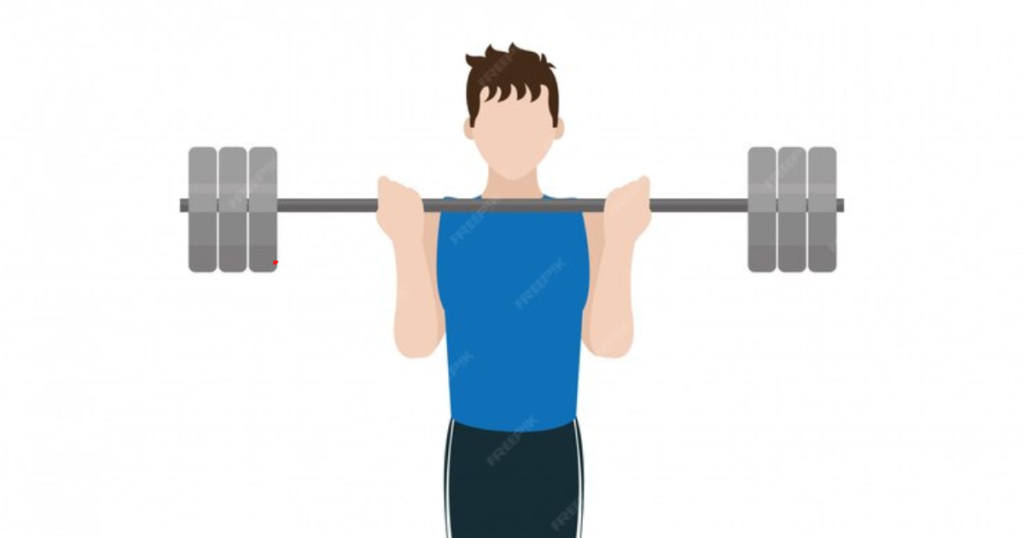
2. Incline Dumbbell Curl
The incline dumbbell curl works the long head of the biceps while also exercising the stabilizing muscles in the shoulders and upper back. Performing this exercise on an incline bench isolates the biceps and prevents cheating through momentum.
How to do it:
- Set an incline bench to a 45-degree angle and sit back with a dumbbell in each hand.
- Allow your arms to hang straight down with your palms facing forward.
- Keeping your upper arms stationary, exhale as you curl the dumbbells towards your shoulders.
- Contract your biceps at the top of the movement, then slowly lower the weights back to the starting position.
- Repeat for the desired number of repetitions.
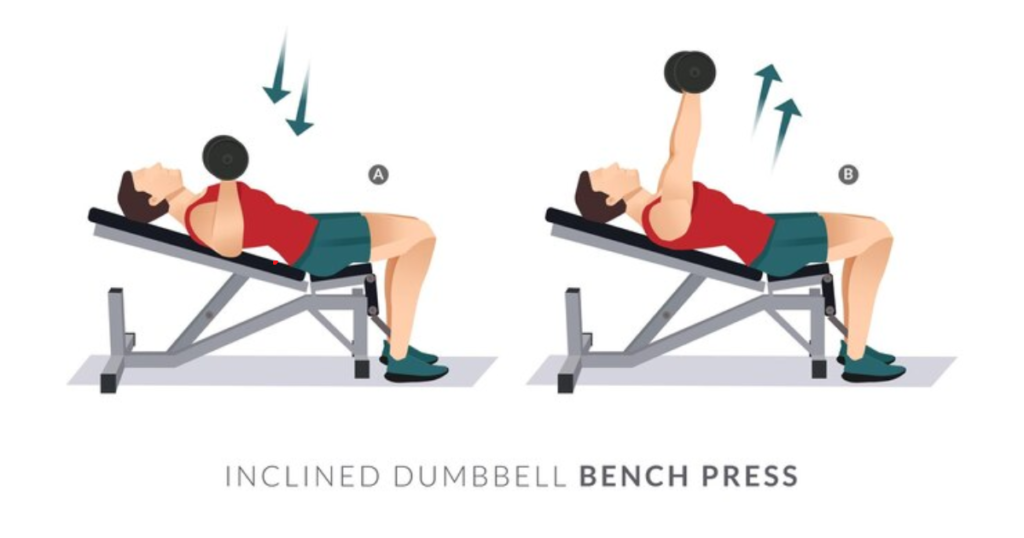
3. Hammer Curl
The hammer curl is a versatile bicep exercise that works both the long head and the brachialis muscle, located beneath the biceps. This exercise is performed with a neutral grip, similar to swinging a hammer.
How to do it:
- Stand tall with a dumbbell in each hand, palms facing your body.
- Keep your elbows close to your sides and exhale as you curl the dumbbells towards your shoulders.
- Maintain a neutral wrist position throughout the movement.
- Squeeze your biceps at the top of the motion, then slowly lower the dumbbells back to the starting position.
- Repeat for the desired number of repetitions.
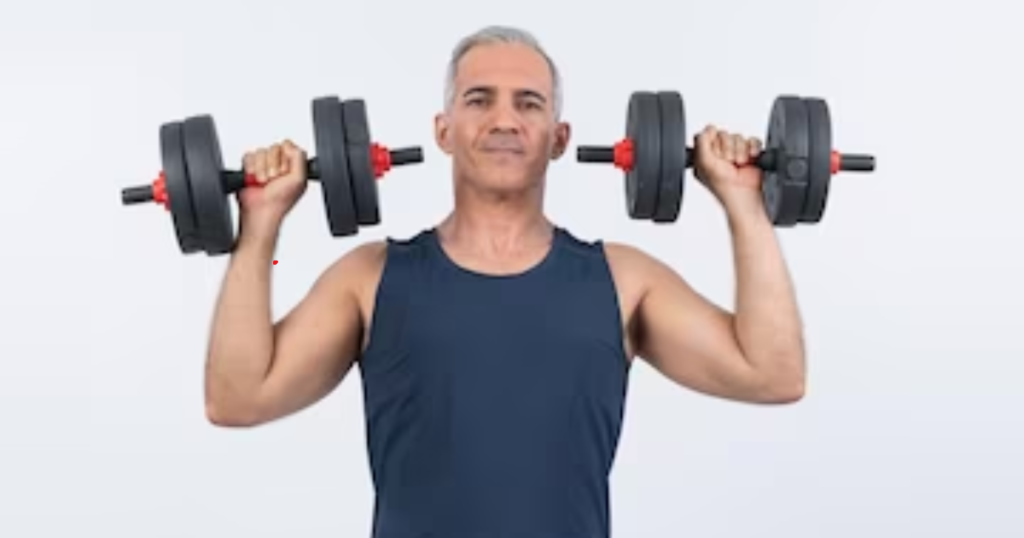
4. Cable Curl
The cable curl is an effective isolation workout that maintains consistent bicep tension throughout the movement. A cable machine provides a smooth and controlled range of motion, making it excellent for working the long head of the biceps.
How to do it:
- Attach a straight or EZ-curl bar to a low pulley cable machine.
- Stand with your feet shoulder-width apart and grab the bar with an underhand grip.
- Keep your elbows close to your sides and exhale as you curl the bar towards your shoulders.
- Contract your biceps at the top of the movement, then slowly lower the bar back to the starting position.
- Repeat for the desired number of repetitions.
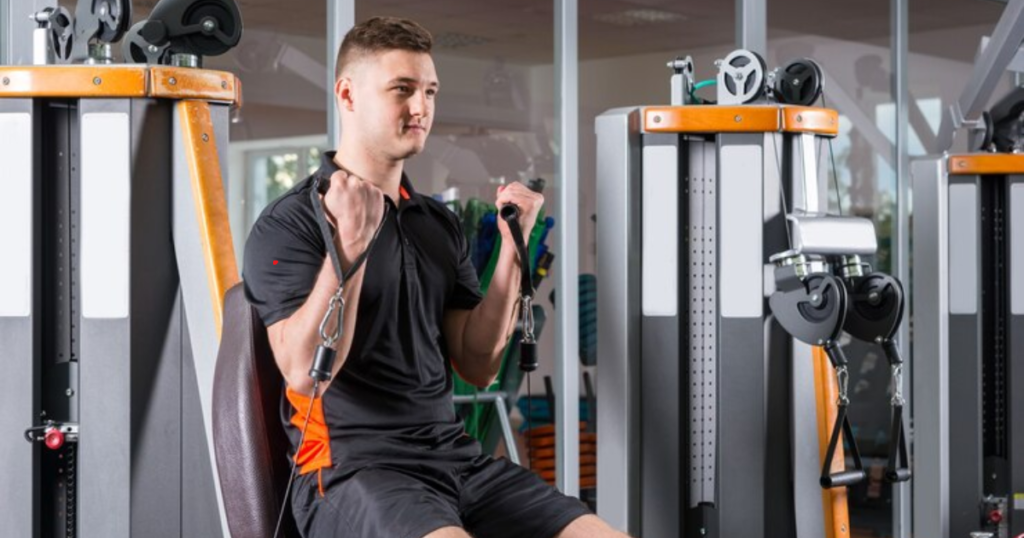
5. Preacher Curl
The preacher curl is a terrific exercise for working the long head of the biceps while minimizing cheating through momentum. Performing this exercise on a preacher bench stabilizes the upper arms while isolating the biceps for optimal efficiency.
How to do it:
- Adjust the preacher bench so that your upper arms rest comfortably on the pad and your armpits are just above the top.
- Grasp an EZ-curl bar or dumbbells with an underhand grip and let your arms hang straight down.
- Exhale as you curl the weight towards your shoulders, keeping your elbows stationary.
- Squeeze your biceps at the top of the movement, then slowly lower the weight back to the starting position.
- Repeat for the desired number of repetitions.
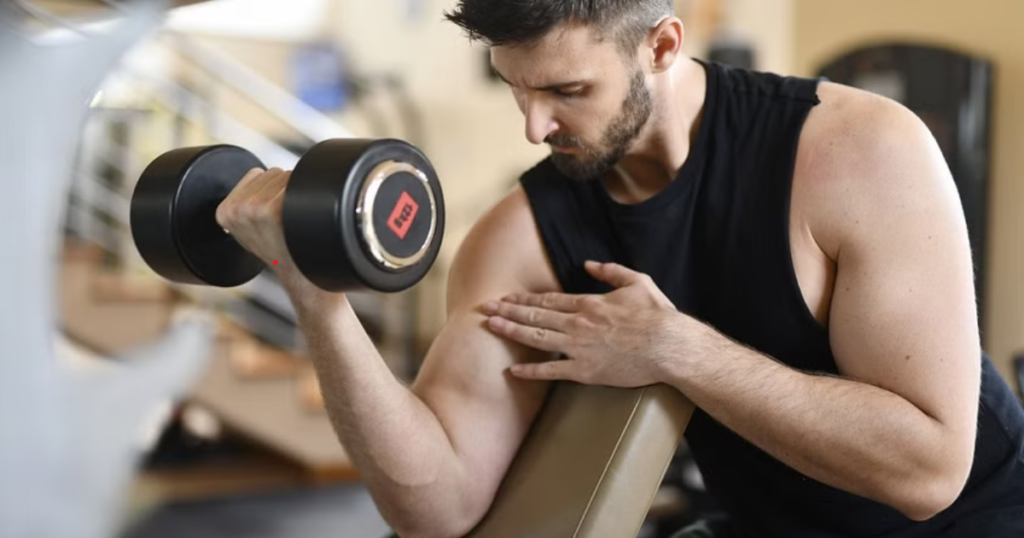
Tips to Do Long Head Bicep Exercises Effectively
To perform long head bicep exercises effectively and maximize their benefits, consider the following tips:
- Maintain perfect form throughout each exercise to properly target the long head of the biceps while reducing the chance of damage. Ensure that your movements are regulated and intentional.
- Focus on contracting the long head of the biceps with each repetition. Visualize the muscle contracting and concentrate on the tension in the targeted spot.
- To fully engage the long head of the biceps and encourage muscle growth, perform workouts that use the whole range of motion. Avoid reducing your range of motion or using momentum to lift weights.
- Select weights that allow you to do the exercise properly while also pushing your muscles. To maintain improvement, gradually raise the weight as your strength develops.
- Include a range of long head bicep exercises in your training program to hit the muscle from different angles and drive growth. Examples include incline dumbbell curls, hammer curls, preacher curls, and concentration curls.
- Consider completing a pre-activation exercise before your primary long head bicep workouts to help isolate and engage the muscle. This could involve exercises such as cable curls or band curls.
- Focus on the eccentric (lowering) portion of each repetition. Lower the weight gradually, resisting the impulse to let it drop too quickly. This promotes maximum muscle activation and growth.
- Allow enough time between sets and sessions to help muscles recover and grow. Overtraining can slow progress, so listen to your body and give it the rest it requires.
- Keep your muscles challenged by gradually increasing the intensity, volume, or resistance of your long head bicep workouts over time. This progressive loading technique is essential for promoting muscle growth and strength increases.
Common Long Head Bicep Exercises Mistakes
Avoiding common mistakes during long head bicep exercises is crucial to ensure effectiveness, prevent injury, and maximize results. Here are some common mistakes to watch out for:
- Using Momentum: Maintain control during weightlifting to ensure effective targeting of the long head of the biceps, as swinging or lifting with momentum can distract focus.
- Partial Range of Motion: To maximize muscle activation and growth during exercise, ensure full range of motion, including fully extended arms and fully contracted biceps, at the end of the exercise.
- Improper Form: Poor form can increase biceps injury risk. Maintain proper posture, avoid shoulder movement, and maintain steady elbows during workouts.
- Lifting excessively Heavy: Using excessively heavy weights can impair form and raise the risk of injury. Select weights that will allow you to do the exercises with good form and control while also pushing your muscles.
- Neglecting the Eccentric part: Skipping the eccentric (lowering) part of a workout might reduce muscle growth and strength improvements. Lower the weights under control while resisting gravity to increase muscle stimulation.
- Ignoring muscular Imbalances: Focusing on biceps’ long head without addressing upper body imbalances can lead to injury. Use exercises targeting arms and shoulders for balanced development.
- Lack of Variation: Repeating long head bicep workouts can lead to plateaus and reduced results. To maintain muscle progress, mix up workouts and training strategies.
- Not Allowing Enough Recovery: Overtraining the biceps without proper rest and recovery can hinder growth and increase the risk of overuse issues, so it’s crucial to allow sufficient rest between sessions.
- Poor Breathing Technique: Maintaining consistent breathing technique, exhaling during the concentric phase and inhaling during the eccentric phase, can improve performance and activity efficiency.
What’s The Best Rep Range For Biceps?
The most effective rep range for biceps is highly dependent on your personal goals, fitness level, and overall training program. A popular tip for biceps training is to use a variety of rep ranges to guarantee complete muscle stimulation and growth.
- Heavy Weight, Low Reps (1-5 reps): Using heavy weights with low repetitions is mostly for strength development. This rep range is useful for developing biceps strength and stimulating fast-twitch muscle fibers.
- Moderate Weight, Moderate Reps (6-12 reps): This rep range is frequently considered ideal for muscular hypertrophy or growth. Moderate weights and repetitions promote muscular fatigue and metabolic stress, both of which are necessary for muscle growth.
- Light Weight, High Reps (12+ reps): Using lesser weights with more repetitions emphasizes muscular endurance and metabolic conditioning. This rep range can help improve muscular endurance and blood flow to the muscles, hence improving recovery.
Are Supplements Needed For Quick Muscle Gains?
Supplements can help enhance muscle gains, but they are not a substitute for a well-designed workout routine, proper nutrition, sufficient rest, and consistency. Some supplements can support muscle growth and recovery, such as protein powder, creatine, BCAAs (branched-chain amino acids), beta-alanine, caffeine, and fish oil.
Protein is essential for muscle repair and growth, while creatine increases strength and muscle mass during high-intensity activities. BCAAs reduce muscle breakdown and improve recovery.
However, individual responses to supplements vary, so it’s crucial to assess their effectiveness and consult a healthcare professional before starting a new supplement regimen.
Related: Brachioradialis Workout: Muscle Growth and Strength
Final Words
Doing exercises that work the long part of your arm muscles can help make your arms look strong and nice. To do this, you need to pick the right exercises and do them properly. This will make your arm muscles bigger and more defined.
People Also Ask
What are long head bicep exercises?
Long head bicep exercises are routines that primarily target the long head of your biceps muscles. These workouts serve to develop and strengthen the upper arm muscles, giving your arms a more defined and toned appearance.
Why should I focus on long head bicep exercises?
Long head bicep workouts are beneficial for establishing a balanced and proportionate arm muscle. By focusing on the long head of the biceps, you can improve total arm strength and appearance.
What are some effective long head bicep exercises?
Concentration curls, incline dumbbell curls, and preacher curls are all good exercises for long head biceps. These workouts focus on the long head of the biceps, allowing you to properly work and build this muscle group.
How often should I do long head bicep exercises?
The frequency at which you perform long head bicep exercises is determined by your fitness goals and overall workout plan. In general, it is recommended that you add these exercises into your arm workout routine at least 1-2 times per week to allow for adequate muscle recovery.
Are long head bicep exercises suitable for everyone?
Long head bicep exercises are suitable for the majority of people, but proper form and technique are required to avoid injury. If you have any current arm or shoulder issues, you should contact with a fitness professional or physical therapist before adding these exercises to your routine. Listen to your body and begin with smaller weights if you’re new to these workouts.

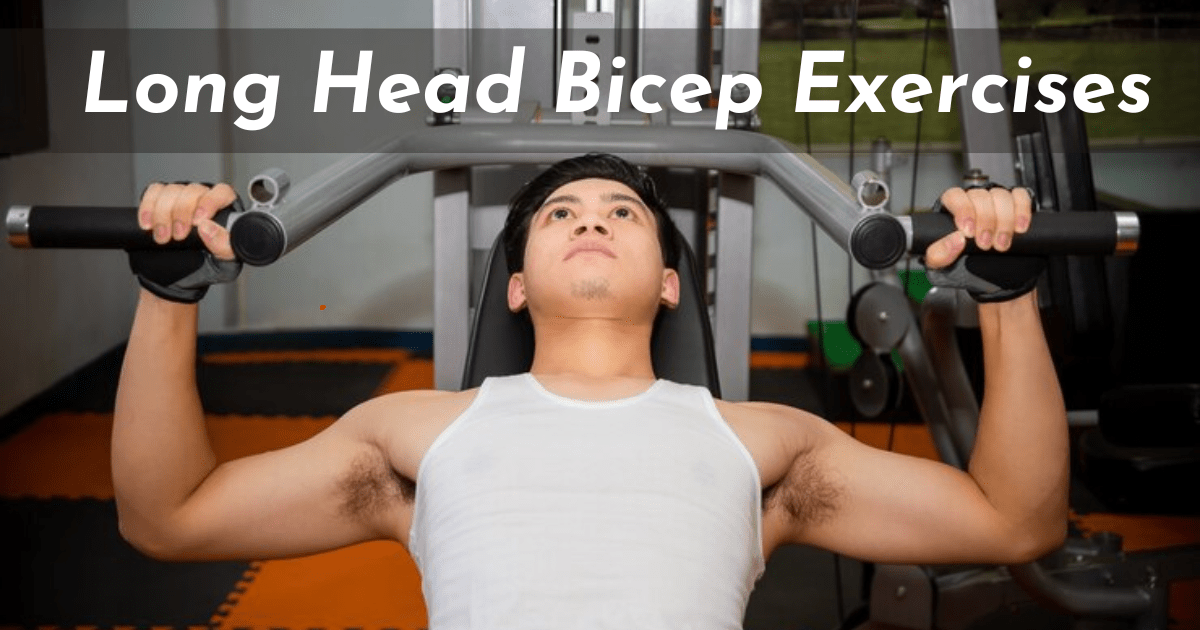







Leave a Reply